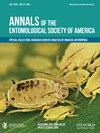屎壳郎部落分类(鞘翅目:金龟甲科:金龟甲科):进展、问题与展望
IF 1.8
3区 农林科学
Q1 ENTOMOLOGY
引用次数: 0
摘要
摘要金龟子亚科传统上根据属群之间的形态相似性甚至单个属所表现出的不同而划分为部落。虽然在过去的220年里,人们描述了各种各样的部落单位,但最近,通过一些部落内部的同义词,它们已经减少到最多只有12个。然而,随着形态学和分子分支系统学的出现,很明显,在系统发育和表型部落分类之间存在许多差异。因此,通过重新验证一些部落或描述新的分组,部落的数量现在已经扩大到20个,尽管这个修订是不完整的。因此,本研究提供了一个全面的审查,目前的现状,屎壳虫部落分类的有效性方面的单系与多系或类。本文讨论了金龟子科各部落的系统地位,并对各部落的属结构和种结构进行了综述。考虑到在几个部落中存在持久的多生或半生现象,很明显,需要对进一步的部落单位进行描述或重新验证以解决差异。因此,我们讨论了如何利用多种证据(分子、形态学、生物地理学和古生物学)来构建屎壳虫的生命树,从而为该谱系的部落分类提供稳定的依据。本文章由计算机程序翻译,如有差异,请以英文原文为准。
Dung beetle tribal classification (Coleoptera: Scarabaeidae: Scarabaeinae): progress, problems, and prospects
Abstract The subfamily Scarabaeinae has been traditionally divided into tribes on the basis of morphological similarity between groups of genera or, even, dissimilarity shown by a single genus. Although various tribal units have been described over the past 220 years, they had been recently reduced to a maximum of only 12 through synonymies within some tribes. However, following the advent of morphological and molecular cladistic systematics, it is clear that there are many discrepancies between phylogeny and phenetic tribal classification. As a result the number of tribes has now been expanded to 20 by revalidating some tribes or describing new groupings although this revision is incomplete. Thus, this study provides a comprehensive review of the current status of dung beetle tribal classification with regards to validity in terms of monophyly versus polyphyly or paraphyly. We discuss the systematic position of tribes among Scarabaeinae and provide a summary of the generic and species structure for each tribe. Given the enduring polyphyly or paraphyly in several tribes, it is clear that further tribal units will need to be described or revalidated to resolve the discrepancies. Therefore, we discuss how to use multiple lines of evidence (molecular, morphological, biogeographical, and paleontological) to build the tree of life for dung beetles and consequently provide stability in the tribal classification of the lineage.
求助全文
通过发布文献求助,成功后即可免费获取论文全文。
去求助
来源期刊
CiteScore
4.90
自引率
0.00%
发文量
25
审稿时长
6-12 weeks
期刊介绍:
The Annals of the Entomological Society of America exists to stimulate interdisciplinary dialogue across the entomological disciplines and to advance cooperative interaction among diverse groups of entomologists. It seeks to attract and publish cutting-edge research, reviews, collections of articles on a common topic of broad interest, and discussion of topics with national or international importance. We especially welcome articles covering developing areas of research, controversial issues or debate, and topics of importance to society. Manuscripts that are primarily reports of new species, methodology, pest management, or the biology of single species generally will be referred to other journals of the ESA. The most important criteria for acceptance are quality of work and breadth of interest to the readership.

 求助内容:
求助内容: 应助结果提醒方式:
应助结果提醒方式:


